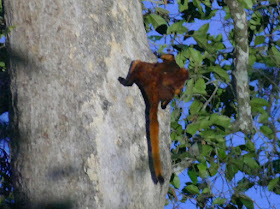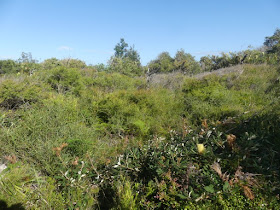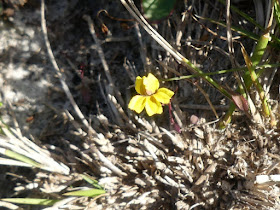Sepilok is a leafy settlement a little to the west of Sandakan, which is the second largest city of Sabah, in Malaysian Borneo. The Orang Utan Rehabilitation Centre and adjacent Sun Bear Conservation Centre are major tourist attractions - but I'm pleased to say that this is definitely not the reason for their existence.
Primary rainforest comes right to the edge of town, which is really pretty special.
 |
Primary rainforest along the track to the rehabilitation centre ,which is within easy walk of
some of the best accommodation in Sepilok. |
Once you drive out of town however, in almost any direction, you realise that the appearance of being in an expanse of rainforest is a facade; the Kabili-Sepilok Forest Reserve, which contains the two centres and partially surrounds Sepilok, comprises less than 4,500 hectares. And on the edges the ever-expanding oil palm plantations are pressing hard.
 |
| Just a few minutes drive to the west of Sepilok, the landscape seems to comprise a vast monoculture of oil palms. |
But I haven't yet showed you where I'm talking about.
 |
Sepilok is approximately at the end of the red arrow, south-east of Kota Kinabalu ('KK') and Mount Kinabalu,
near the east coast of Sabah. |
This post is not meant to be one of unremitting gloom, so let's instead focus on the delights of Sepilok, while always being aware of the threats looming over tropical rainforests everywhere.
It's probably fair to say that most visitors to Sepilok don't do much more than drive into to town from Sandakan or KK, walk along the tracks to see the rehabilitation process, hopefully appreciate the animals and the work that's being done, then drive away again. I think that's unfortunate, because this is a very rewarding destination in itself for lovers of wildlife. So much so in fact that I'm going to spread this account over three posts, to do proper justice to it.
Today I'm not even going to get to the rehab centres yet. I'm going to concentrate instead firstly on the gardens of town, and especially of the lovely garden lodge where we stayed - Sepilok Jungle Resort for the record, but it seems to be fairly typical of others in the immediate vicinity. I'll follow with a fairly brief introduction to the nearby Rainforest Discovery Centre, set in the forest itself, and conclude with the rehabilitation centres.
(A disclaimer; I wasn't particularly happy with the camera I had on both these trips. On the other hand I can clearly hear my mother commenting that a poor worker always blames his tools!)
Here are a coupe of glimpses of the lodge grounds.
 |
| Part of the lengthy walkway from the rooms to the dining room. |
 |
| The grounds, from the above walkway. |
 |
| The view from the dining room deck. |
Bird life in and around the lodge grounds was pretty impressive.
 |
Asian Glossy Starling Aplonis panayensis; this species is widespread and common, but I come from a country
with only one native starling (similar to this one, but restricted to tropical coastal Queensland), plus a couple
of very damaging exotics, so I'm predisposed to liking (and even envying) others' native starlings!
|
 |
Oriental Magpie Robin Copsychus saularis (actually one of the Old World Flycatchers). Another ubiquitous
species in Borneo and beyond, but another I'm fond of. I think I just caught this one as it moved, rather than exhibiting
any particular behaviour (since there was no direct sun it would be hard to come up with an explanation anyway!).
|
Some of the best birding was to be had from the restaurant balcony, with the extensive pond below and vegetation, including flowers and fruits, immediately in front of us. (And of course it would have been rude to occupy the seats without purchasing a drink.)
 |
Yellow-rumped Flowerpecker Prionochilus xanthopygius. Flowerpeckers are lovely birds belonging to a Family
of some 45 species from south and south-east Asia, and represented in Australia by the Mistletoebird Dicaeum hirundinaceum. This is the better picture, but the slightly fuzzy one below better shows its colours. |
And speaking of substandard photos, here's another, but justified by its subject, which is both beautiful and very interesting.
 |
Black-and-Red Broadbill Cymbirhynchus macrorhynchos. The broadbills are a group of 15 African and Asian
passerines belonging to a predominantly South American basic subgroup of passerines, the Suboscines.
The group dominates in South America, but outside there the broadbills are joined only by the pittas and the four Madagascan asities. (The New Zealand wrens, of which only one species survives, are now regarded as so ancient
that they form a third subdivision of passerines.)
|
I find sunbirds a serious challenge to photograph (a challenge which I usually fail, needless to say), but this one cooperated.
 |
Red-throated Sunbird Anthreptes rhodolaemus.I wish I could have shown you her gorgeous mate too, but you'll just have to look him up!
|
The hanging feeders, which weren't as popular as the flowers this time, did attract other visitors though.
 |
Prevost's Squirrel Callosciurus prevostii. This one was a mystery for a while - the illustrations in the guides have
dazzling white sides - until I discovered that the north-eastern Borneo race does not... The distinctive rufous
undersides didn't show up up in the dull late afternoon light - they are quite visible however in this
(otherwise forgettable) flash photo.
|
Perhaps the star of the balcony however was a regular visitor to the pond.
 |
Blue-eared Kingfisher Alcedo meninting. Again widespread in south-east Asia, this little beauty
is one of the fishing kingfishers.
|
It wasn't always sunny though over the pond incidentally, this being the tropics!
Another kingfisher, which I was lucky enough to get close views of from the walkway, possibly even overshadowed the delightful little Blue-eared however, at least in my mind, mostly because it is so different from any other kingfisher I've ever seen.
 |
Stork-billed Kingfisher Pelargopsis capensis. Despite being one of the tree-kingfishers, mostly
woodland hunters, this magnificent species spends a lot of time fishing, as this one was.
It is found from India to the Philippines and the Lesser Sundas near Timor.
|
There was plenty to see elsewhere in the grounds too of course, by night as well as day, though our night walk wasn't as productive as we'd hoped. These two lovelies were pretty much the sole reward for our torchlight stroll. I have no idea as to their identity beyond the obvious, so any assistance gladly accepted, as ever.
Early mornings were more productive, though a lot of the activity was happening frenetically and high in the flowering trees, beyond the capacity of my camera at the time. This is as close to a showable photo as I could get of the numerous sunbirds present.
 |
Crimson Sunbird Aethopyga siparaja. They really are exquisite.
(The species name, by the by, is from a Malay word for an army general!)
|
 |
Little Green Pigeon Treron olax. Yes, it is little and green and high up!
It was enthusiastically tucking into the figs around it.
|
Another non-prize-winning pic, but of a very rare bird that unexpectedly flew overhead.
 |
Storm's Stork Ciconia stormi is the world's rarest stork (a dubious distinction it shares with the Greater Adjutant),
with an estimated maximum population of less than 500 scattered in southern Thailand, mainland Malaysia,
Sumatra and Borneo. Ongoing loss of its lowland riverine rainforest and peat forest is to blame.
|
And lastly for today, one of the most magnificent birds I know - this one was actually in the gardens of the lodge across the road.
 |
Rhinoceros Hornbill Buceros rhinoceros, always a thrill and an astonishment.
The function of the incredible casque is uncertain, but it must be significant, as in some
species it can account for 10% of the bird's whole body weight.
|
Hopefully I've managed to whet your appetite for Sepilok, but don't go until I've talked about the Rainforest Discovery Centre in a briefer post next time.
NEXT POSTING THURSDAY
(And
remember that you can get a reminder when the next post appears by
putting your email address in the Follow by Email box in the top right
of this screen.
And I'd love to receive your comments - it's easy and you don't need to sign in!)


































































